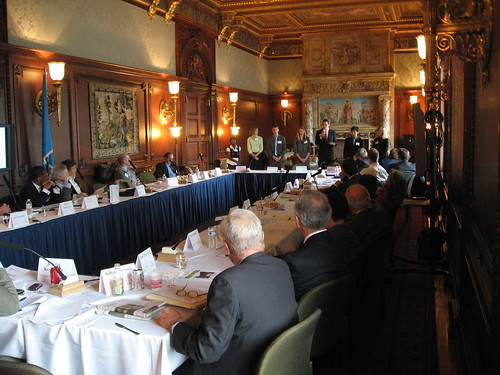Ballard Metcalfe Presents Policy Recommendations on Greenhouse Gas Emissions in Session at National Energy Board
October 16, 2009 | Academics, News, Student Success | No Comments

Ballard Metcalfe of Eminence, Ky., didn’t seem nervous as he stood before a panel of legislators, policy advocates and business leaders in a meeting room of the Library of Congress.
Metcalfe, a senior at the Carol Martin Gatton Academy of Mathematics and Science in Kentucky at WKU, along with representatives from six other specialized high schools shared research on reducing greenhouse gas emissions on Oct. 14 to The Keystone Center’s National Energy Board in a session held in Washington, D.C.
Metcalfe wasn’t worried that his audience would dismiss the group’s message because of their age. Instead, it made him all the more confident.
“Students are able to create solutions that are ultimately bipartisan and pragmatic solutions, without many of the anxieties our current leaders face, such as protecting their own power,” Metcalfe said. “We are objective and our only goal is for the future.”
The Energy Board is a unique group of 50 national leaders on energy policy issues. Metcalfe and his colleagues from other National Consortium for Specialized Secondary Schools of Math, Science and Technology (NCSSSMST) schools were granted a tremendous opportunity to take action and affect energy policy in the country today, and as they consider their college and career choices in the future.
The proposal’s genesis came during the 8th Keystone National Youth Policy Summit (YPS). In June 2009, 30 students from seven math and science schools from across the country came together in Keystone, Colo., to develop consensus-based recommendations on reducing greenhouse gas emissions across the United States.
Additional Gatton Academy students participating in the conference included Elaine Flynn of Demossville, Ky., Alexander Hare of Morehead, Ky., Holly Mitchell of Salvisa, Ky., Kaitlin Oliver of Central City, Ky., and Hunter Smith of Elizabethtown, Ky.
The summit and subsequent white paper allowed participants to take stock of the larger technical, legal, environmental, social, economic, and political problems associated with current and future reductions in emissions across 10 sectors of the economy. Students shared their own research, sharpened the definition of the issues and options, and sought consensus on recommendations.
Derick Strode, the academy’s coordinator for research, internships, and scholarships, explained the summit and presentation were an extraordinary opportunity to combine advanced research with real implications.
“This was a chance for Ballard to apply his research, learning, and ideas to an important, real-world application,” Strode said. “As one member of the energy board pointed out, the presentation was especially influential because the students’ were not coming with any special interests to represent.”
Given the global emphasis on reducing greenhouse emissions, the topic serves as both a timely and relevant for emerging young leaders in science and mathematics. With guidance from the experts in science and public policy, these high school students produced viable approaches to dealing with a problem that is confounding national policy makers as well as those in state legislatures across the U.S.

“Reducing greenhouse gases will be of utmost importance for the preservation of the environment for my generation, and many generations to come,” Metcalfe said. “It is important that we work towards achieving the goal of reducing greenhouse gases before it is too late, and one way to work toward that goal is by means of our recommendations.”
The findings were reported to energy and government leaders within their communities. Greenhouse Gas Reductions in the U.S. (PDF Link) represents the results of the students’ deliberations in the form of a written set of consensus recommendations.
Participants noted, if implemented fully and completely, the suggestions in this proposal would, over a four-decade time horizon, slow, stop and then reverse the trend of increasing carbonemissions in the United States. The primary driving force for these reductions in emissions is a market-oriented cap-and-trade system. Although the consensus statement was developed separate from, and independently of, other national initiatives, the economics bears striking similarities to H.R. 2454, or the Waxman-Markey Bill, which passed the House on June 26, 2009 — two weeks after the end of the student summit.
Student participants acknowledged the proposal is a compromise, and that it is not a perfect or a complete solution to the climate problem facing the United States. Instead, the policy suggestions were offered as possible catalysts for a shift in the nation’s perception of pollution, environmentally-friendly lifestyles, and policy making.
Metcalfe shared the advice given to him by a member of the board after Wednesday’s session.
“There are many people on either end of the spectrum, those in academia on one side, and the policymakers and politicians on the other,” he said. “Many times, these groups are not proficient at communicating ideas or understanding one another. Mediating between the two sides is an important task in our age, one that requires people who possess skills in both areas. Hard work on the part of people like myself and the other students who attended the YPS will be needed in order to mediate between the two ends of the spectrum, in order to form the policy that will make the world a better place for all.”
For information, contact Derick Strode at (270) 745-3167.


